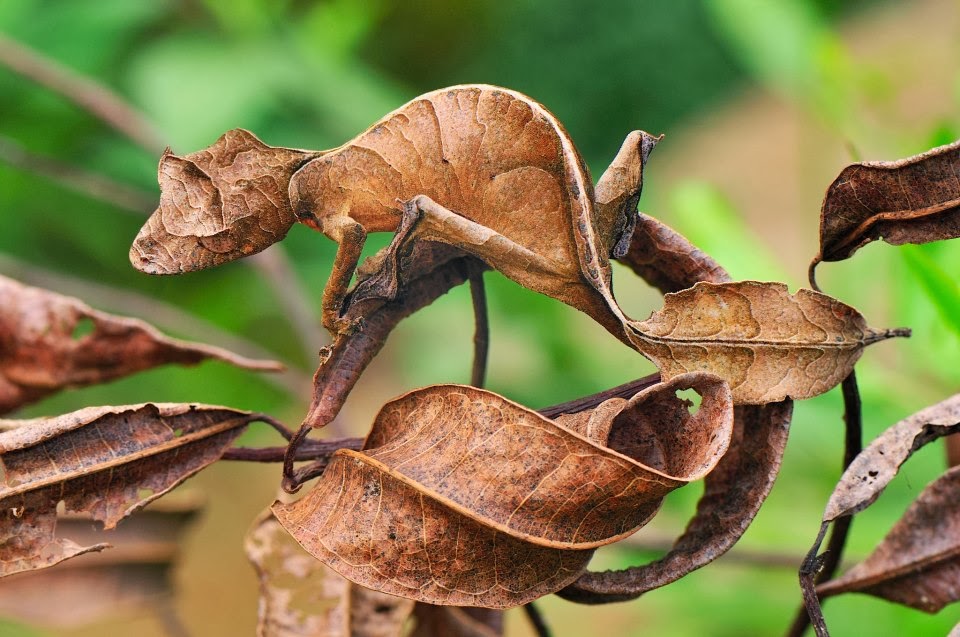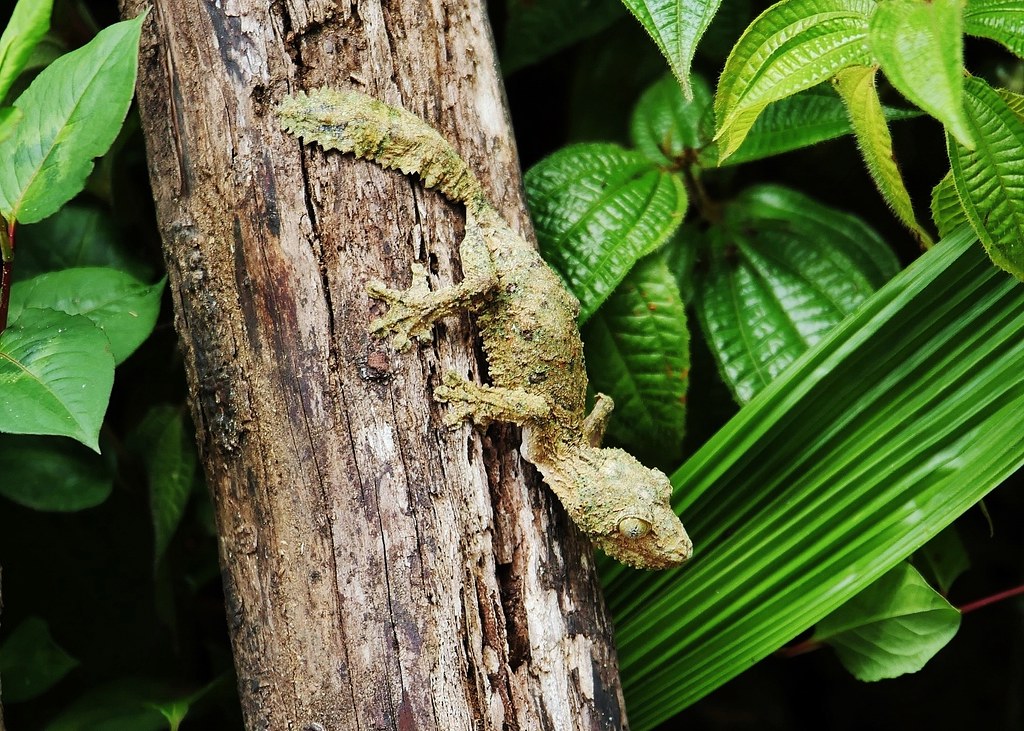Table of Contents
ToggleIntroduction
The natural world is home to many remarkable creatures; each uniquely adapted to its environment. Among these fascinating beings is the leaf-tailed gecko, a master of camouflage and adaptation. With its astonishing ability to blend seamlessly into its surroundings and an array of specialized features, the leaf-tailed gecko showcases the intricate interplay between form and function in the animal kingdom.
Taxonomy And Classification
Kingdom: Animalia (Animals)
Like all multicellular and heterotrophic organisms, the leaf-tailed gecko belongs to the kingdom Animalia. This diverse group encompasses many species that exhibit complex behaviors, various morphologies, and specialized adaptations.
Phylum: Chordata (Chordates)
Leaf-tailed geckos are chordates belonging to the phylum Chordata. This species includes animals with particular defining characteristics, such as a notochord, a dorsal nerve cord, pharyngeal slits or pouches, and a post-anal tail during at least one stage of their life cycle.
Class: Reptilia (Reptiles)
As reptiles, leaf-tailed geckos fall within the class Reptilia. This class comprises a diverse group of cold-blooded vertebrates characterized by their scaly skin, internal fertilization, and amniotic eggs.
Order: Squamata (Scaled Reptiles)
You’ll find the leaf-tailed gecko in Squamata, an order that includes lizards, snakes, and amphisbaenians. Scalded skin, blinkable eyelids, and various means of mobility are all traits shared by members of the Squamata order.
Suborder: Sauria (Lizards)
Within the order Squamata, the leaf-tailed gecko falls under the suborder Sauria, commonly called lizards. This suborder includes various lizard species with varying morphological and ecological adaptations.
Infraorder: Gekkota (Geckos)
The infraorder Gekkota encompasses geckos, a group of lizards known for their adhesive toe pads, vocalizations, and diverse habitats. Leaf-tailed geckos are part of this infraorder, sharing specific characteristics with other gecko species.
Family: Gekkonidae (Geckos)
Leaf-tailed geckos belong to the Gekkonidae family, one of the largest and most diverse families of lizards. This family includes geckos with varying adaptations, behaviors, and habitats.
Genus: Uroplatus
Uroplatus is the genus that contains the leaf-tailed gecko. Different species of leaf-tailed geckos belong to the same genus because they all have similar body proportions, camouflage techniques, and arboreal adaptations.
Species: Various Species within the Genus Uroplatus
Within the genus Uroplatus are several recognized species of leaf-tailed geckos, each exhibiting its own characteristics and adaptations. Some well-known species within this genus include Uroplatus phantasticus (Satanic Leaf-Tailed Gecko) and Uroplatus sikorae (Mossy Leaf-Tailed Gecko).
Physical Characteristics

The unique look of leaf-tailed geckos is essential to their continued existence in the wild.
- Body Shape and Camouflage: The most striking feature of leaf-tailed geckos is their body shape, which resembles a leaf’s edge or a piece of bark. This camouflage allows them to blend seamlessly into tree trunks and branches, making them nearly invisible to predators and prey.
- Skin Texture: Their skin texture often mimics the texture of tree bark or leaves, further enhancing their camouflage. Some species even have raised, rough scales that imitate the roughness of tree bark.
- Coloration: Leaf-tailed geckos exhibit a variety of colors and patterns, ranging from earthy browns to vibrant greens. These colors match the foliage of their habitat, contributing to their effective disguise.
- Leaf-like Appendages: In addition to their body shape, some species possess fringed, leaf-like projections on their bodies, enhancing their resemblance to leaves and camouflage.
- Eyes: Their large, round eyes have vertical pupils and are adapted for low-light conditions, allowing them to be active at night while remaining inconspicuous during the day.
Adaptations And Behavior
Leaf-tailed geckos have developed an array of adaptations that aid their survival in their specific ecological niche:
- Nocturnal Lifestyle: These geckos are nocturnal, remaining active at night to avoid daytime predators and take advantage of their specialized vision.
- Slow Movement: Their deliberate, slow movements contribute to their illusion of being part of their surroundings, allowing them to move stealthily without revealing their presence.
- Cryptic Behavior: When threatened, leaf-tailed geckos often freeze in place, relying on their camouflage to protect them from predators. This cryptic behavior is a crucial survival strategy.
- Tail Autotomy: Like other gecko species, leaf-tailed geckos can shed their tails as a distraction when predators confront them. The detached tail may wriggle, diverting attention from the gecko itself.
Habitat and Distribution Of The Leaf-Tailed Gecko
The leaf-tailed gecko (genus Uroplatus) is a captivating reptile renowned for its incredible camouflage and adaptation to specific ecological niches. These geckos are masters of blending seamlessly into their surroundings, making them ideally suited for their unique habitats. In this section, we explore the diverse habitats they inhabit and their distribution across various regions.
Habitat Diversity
Leaf-tailed geckos are arboreal creatures adapted to live in trees and shrubs. Their specialized physical features, such as their leaf-like appearance, help them remain virtually invisible amidst the foliage. While they share this arboreal lifestyle, different species of leaf-tailed geckos have adapted to different habitats within their native regions.
Tropical Rainforests
Many leaf-tailed gecko species occur to be in tropical rainforests. These lush environments provide ample cover in the form of dense vegetation, providing the geckos with a multitude of places to hide. The damp and humid conditions of rainforests are also favorable for these moisture-dependent creatures.
Madagascar’s Ecosystems
Madagascar, the fourth-largest island in the world and a biodiversity hotspot, is home to many leaf-tailed gecko species. These geckos have evolved to inhabit various ecosystems within the island’s diverse landscapes:
Montane Forests: Some species happen in montane or mountainous forests, where they dwell in the high canopy of trees. These forests offer unique challenges and resources that have shaped the geckos’ adaptations.
Lowland Rainforests: Other species inhabit the lowland rainforests of Madagascar. These geckos thrive in the humid, dense undergrowth and canopy, using their camouflage to remain inconspicuous and avoid predators.
Indian Ocean Islands
Aside from Madagascar, leaf-tailed geckos can also happen upon neighboring islands in the Indian Ocean, including the Comoros Islands and the Seychelles. These islands’ unique ecosystems and habitats contribute to the diversity of leaf-tailed gecko species.
Preferred Microhabitats
In their chosen habitats, leaf-tailed geckos prefer specific microhabitats that best suit their camouflage and foraging strategies. These include:
Tree Trunks and Branches: Many species of leaf-tailed geckos are adept at blending in with tree bark and branches, often assuming a position where their body shape mimics the contours of their surroundings.
Leaf Litter and Undergrowth: Some species inhabit the leaf litter on the forest floor, using their cryptic coloration to disappear among fallen leaves and debris.
Canopy: In the forest canopy, leaf-tailed geckos find refuge among the leaves and branches. Their ability to remain motionless and camouflage themselves helps them avoid detection by predators.
Nocturnal Lifestyle
Leaf-tailed geckos are primarily nocturnal, meaning they are most active during the night. This behavior allows them to exploit the cover of darkness while minimizing their exposure to potential predators, many active during the day.
Reproduction And Life Cycle
Leaf-tailed geckos reproduce through sexual reproduction, with males engaging in courtship behaviors to attract females. After successful mating, females lay eggs, often buried or hidden in leaf litter or other suitable spots. The eggs hatch, giving rise to miniature versions of the adults, and these hatchlings gradually develop the characteristics and adaptations that enable them to thrive in their environment.
Conservation And Threats
The conservation status of leaf-tailed geckos varies among species and regions. Habitat loss due to deforestation and urbanization significantly threatens their survival. Their specialized adaptations and camouflage make them attractive targets for the illegal pet trade. Conservation efforts focus on protecting their natural habitats and raising awareness about their ecological importance.
Interactions with Humans
With their unique appearance and behaviors, leaf-tailed geckos captivate the interest of herpetologists, nature enthusiasts, and researchers. Their role in their ecosystems as predators of insects helps maintain the balance of local populations. However, human activities have also challenged their survival, underscoring the need for responsible conservation practices.
Conclusion
The leaf-tailed gecko is a testament to the complexity of evolution and adaptation. Through a combination of remarkable camouflage, specialized behaviors, and intricate features, these geckos have carved out their place in the ecosystems they inhabit. The story of the leaf-tailed gecko reminds us of the incredible diversity of life on Earth and the delicate balance required to preserve and protect these enigmatic creatures for generations to come.







